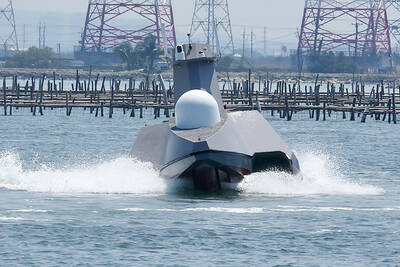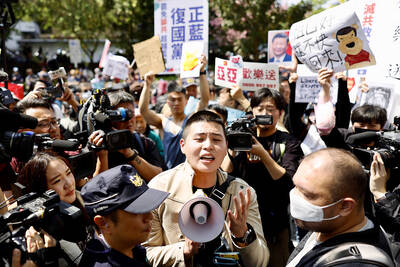China has complained to Japan about comments by a top Japanese diplomat that Taiwan’s political status was up in the air, the Chinese foreign ministry said yesterday, testing ties still scarred by World War II.
Taiwanese activists protested at the de facto Japanese embassy in Taipei on Monday, three days after top Japanese envoy Saito Masaki told a university forum that Taiwan’s status had “not been determined,” angering the Taiwanese government.
“We express our strong dissatisfaction [with the comments],” Chinese foreign ministry spokesman Ma Zhaoxu (馬朝旭) said in a statement on its Web site. “The Chinese government has already made solemn representations with the Japanese side.”

PHOTO: PICHI CHUANG, REUTERS
Japan recognizes China over Taiwan and thus cannot have an official embassy in Taiwan.
Saito said he was stating only personal views and the de facto embassy said it took no official position on Taiwan’s “legal status.”
Chinese spokesman Ma repeated Beijing’s official position that Taiwan is an inseparable part of China.
“Any scheme to try to create discussion on Taiwan’s status is a provocation of China’s core interests and cannot be accepted by the Chinese government or its people,” he said.
Ties between China and Japan are often testy because of Beijing’s insistence that Tokyo has never properly atoned for its brutal occupation of large parts of China during World War II.
Meanwhile, President Ma Ying-jeou (馬英九) yesterday restated his position that the Treaty of Taipei of 1952 affirmed the transfer of Taiwan’s sovereignty to the Republic of China (ROC).
With Saito absent, Ma told Japanese parliamentarian Mitsuhide Iwaki that his visit came at an appropriate time because his administration had just celebrated the 57th anniversary of the signing of the treaty.
Japan and the ROC signed the accord at the Taipei Guest House on April 28, 1952. The Sino-Japanese Peace Treaty, better known as the Treaty of Taipei, affirms the 1951 San Francisco Peace Treaty and states that the Japanese government renounces any claim to Taiwan, Penghu, the Spratly Islands and the Paracel Islands.
It did not, however, specify the legal successor government of the territories.
During the unveiling ceremony in Taipei last week of a sculpture depicting Japanese and ROC representatives signing the treaty, Ma said that the treaty affirmed the transfer of Taiwan’s sovereignty from Japan to the ROC.
On Friday, Saito told a meeting at National Chung Cheng University that Taiwan’s status remained “unresolved.”
Saito later apologized for his remarks after the Ministry of Foreign Affairs lodged a protest and demanded an explanation.
KMT lawmakers also wanted to make Saito persona non grata and have him replaced. Pro-unification groups condemned him, demanding he leave the country and that Tokyo apologize.
Ma said the 1952 pact was significant because it asserted the ROC’s claim over Taiwan, which was returned to the ROC in 1945.
Tokyo and Taipei have a sound relationship, Ma said. Although Japan and the ROC severed ties 20 years after the treaty was signed, Ma said he designated this year as “the year of advancing the special partnership between Taiwan and Japan” with the hope of furthering bilateral ties.
Among many achievements, Ma said Japan had given the green light for a Taiwanese representative office in Sapporo to offer assistance to Taiwanese visitors.

ENDEAVOR MANTA: The ship is programmed to automatically return to its designated home port and would self-destruct if seized by another party The Endeavor Manta, Taiwan’s first military-specification uncrewed surface vehicle (USV) tailor-made to operate in the Taiwan Strait in a bid to bolster the nation’s asymmetric combat capabilities made its first appearance at Kaohsiung’s Singda Harbor yesterday. Taking inspiration from Ukraine’s navy, which is using USVs to force Russia’s Black Sea fleet to take shelter within its own ports, CSBC Taiwan (台灣國際造船) established a research and development unit on USVs last year, CSBC chairman Huang Cheng-hung (黃正弘) said. With the exception of the satellite guidance system and the outboard motors — which were purchased from foreign companies that were not affiliated with Chinese-funded

PERMIT REVOKED: The influencer at a news conference said the National Immigration Agency was infringing on human rights and persecuting Chinese spouses Chinese influencer “Yaya in Taiwan” (亞亞在台灣) yesterday evening voluntarily left Taiwan, despite saying yesterday morning that she had “no intention” of leaving after her residence permit was revoked over her comments on Taiwan being “unified” with China by military force. The Ministry of the Interior yesterday had said that it could forcibly deport the influencer at midnight, but was considering taking a more flexible approach and beginning procedures this morning. The influencer, whose given name is Liu Zhenya (劉振亞), departed on a 8:45pm flight from Taipei International Airport (Songshan airport) to Fuzhou, China. Liu held a news conference at the airport at 7pm,

AIR SUPPORT: The Ministry of National Defense thanked the US for the delivery, adding that it was an indicator of the White House’s commitment to the Taiwan Relations Act Deputy Minister of National Defense Po Horng-huei (柏鴻輝) and Representative to the US Alexander Yui on Friday attended a delivery ceremony for the first of Taiwan’s long-awaited 66 F-16C/D Block 70 jets at a Lockheed Martin Corp factory in Greenville, South Carolina. “We are so proud to be the global home of the F-16 and to support Taiwan’s air defense capabilities,” US Representative William Timmons wrote on X, alongside a photograph of Taiwanese and US officials at the event. The F-16C/D Block 70 jets Taiwan ordered have the same capabilities as aircraft that had been upgraded to F-16Vs. The batch of Lockheed Martin

GRIDLOCK: The National Fire Agency’s Special Search and Rescue team is on standby to travel to the countries to help out with the rescue effort A powerful earthquake rocked Myanmar and neighboring Thailand yesterday, killing at least three people in Bangkok and burying dozens when a high-rise building under construction collapsed. Footage shared on social media from Myanmar’s second-largest city showed widespread destruction, raising fears that many were trapped under the rubble or killed. The magnitude 7.7 earthquake, with an epicenter near Mandalay in Myanmar, struck at midday and was followed by a strong magnitude 6.4 aftershock. The extent of death, injury and destruction — especially in Myanmar, which is embroiled in a civil war and where information is tightly controlled at the best of times —